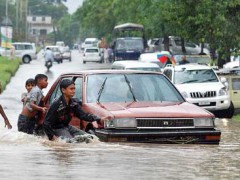What’s a Capital Without the Capital?

“I was stranded on the IJP road and then later at the I-8 for hours on end with the roads all practically flooded. We were literally two people driving the car: one mistimed gear shift and we would have been stranded in the rain on the road for the next 6 hours.”
This was Shaukat’s – then a private chauffeur in a local household – story of what happens in Islamabad, Pakistan’s capital when it rains continuously for more than a few hours or accidentally rains too hard. The IJP is a commercial thoroughfare running the length of Islamabad whilst I-8 is a popular residential bloc in the same. Yet, despite their proximity to the capital, Shaukat’s story is one that can easily be duplicated on any ‘fine’ day in the capital when the downpour sets in.
Stories like these unfortunately are not just restricted to downpours or even only to Islamabad. They equally apply to most of Pakistan’s urban centres – and don’t even spare Pakistan’s provincial capitals!
So what is the problem you might ask? Well, the problem is that we do not have the infrastructure to cope with such problems. Not only are cities like Karachi and Lahore quick to flood when the rain comes hitting; they are all also faced with a host of other problems in the same vein – perpetuated primarily by a lack of infrastructure, and secondarily by the non-availability of resources.
Unfortunately, we are no Singapore. We neither have their social acumen, sense of motivation or responsibility to initiate and bring about an economic, social and infrastructural transformation (1) (2) of a similar magnitude. Our cities continue to expand, and each day their condition worsens from the day before. Such has become the plight of even the country’s largest metropolises that those old enough to do so look back to life in the 60s nostalgically as the quintessential Pakistani lifestyle – which we’ve now lost.
Karachi, for instance, keeps on expanding horizontally into ever farther reaches, yet the city completely lacks an all-connecting road network. Not to mention that most of Karachi does not have access to any sort of water (1) (2), nor any viable electricity or drainage system.
Islamabad is no different, despite being the only successfully planned city in the country. The Capital Development Authority (CDA) which overlooks the developmental affairs of the city has now started developing new residential sectors in the city, the more recent ventures being E-11 and D-12.
And all this despite the fact that Islamabad has similar waste disposal and water treatment problems to Karachi: not to put too fine a point on it, its residents practically drink what they defecate, and Islamabad also has a sizeable shanty and slum ecosystem – lacking in water, electricity, drainage, gas, and well-nigh every other amenity in life.
Lahore, the second largest city in the country falls… well… nicely in the middle of both these stories, tending more towards Karachi’s extreme than Islamabad’s.
Combine this with the fact that the country’s current security situation does not exactly promote investor confidence in pouring sizeable capital into the country to accelerate what little development there already is, and you get the perfect formula for regression.
Here, Karachi’s stock exchange – Pakistan’s largest – deserves special note. We should remember that Karachi contributes well over 20% of Pakistan’s GDP, a figure that rose as high as 45% at one time. Its stock exchange, a key economic factor in Pakistan, has been in a free fall over the course of the last couple of years – shattering what little investor confidence the country had managed to retain since the ‘War on Terror’ started. And the culprits aren’t just the international players -fingers can be also be pointed at the city’s and Pakistan’s own Kalashnikov culture introduced under the late, ‘beloved’ General Zia’s regime. With the current law and order situation, we are losing what little hope metropolises like these have of developing, or of even starting out on the road to recovery!
Admittedly, Singapore is practically a one city nation so comparison is not really fair. However, excuses like these need not be legitimized. There was a time – again often fondly recalled by the older generation – when people would scratch their heads when the name of Pakistan arose, yet their faces would invariably light up with recognition at the name of Karachi. We have lost all that now.
Islamabad, Karachi, Lahore and Faisalabad, these are all major metropolises in the country that continue to expand at the receiving end of urbanisation and migratory pressures. Yet, they expand but they do not grow. Expansion comes in the form of stolen electricity, unsanctioned slums, and dirt packed roads.
Not only have we miraculously managed to make even our most enterprising, economically viable cities irrelevant on the world – and even the regional! – stage, we have managed to do so while making even our most developed cities paint dire pictures of civil war, or ressemble cities from the poorest countries around the world: through sheer abject degeneration.
There simply won’t be any ‘New Cities’ or ‘Renewed Cities’ for Pakistan. It isn’t just that we’re unwilling to put in a concerted, conscious, and responsible effort to do so as Singapore has done; it’s just that we’re consciously and deliberately and with great enterprise working towards our own demise.
Tags: Cities, Civil Society, developing countries, New Cities, Pakistan cities

